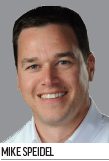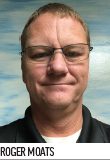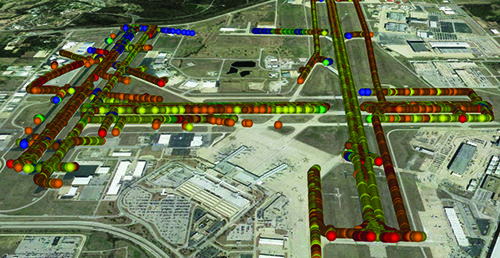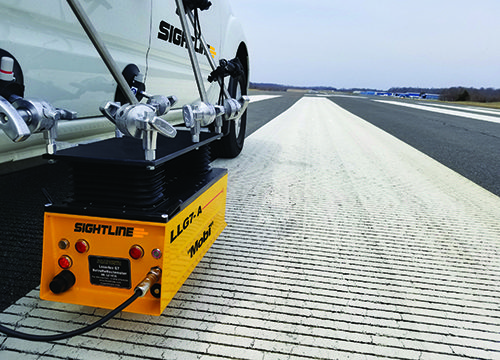Roger Moats, airfield maintenance manager at Tulsa International Airport (TUL), understands that flight safety begins and ends on the ground. It’s why he regularly emphasizes to his crew the importance of their work.
“When I started 20 years ago in this department, we had 20 people. We shrunk that to 10, and we’re doing as much, if not more, than we did with 20,” Moats says. He cites better training and improved equipment as two key factors for the increased productivity.
In August, TUL had its annual FAA Part 139 safety inspection, and for the third year in a row, it came away with zero discrepancies. Moats and his team prepared by checking markings early in the year and compiling a list of which needed work.
|
Project: Airfield Markings Assessment/Reflectivity Testing Location: Tulsa (OK) Int’l Airport Scope: 10,000-foot main runway; 7,736-foot crosswind runway; 6,101-foot general aviation runway Consultant: Sightline Inc. Completed: Spring 2018 Project Duration: 2 nights Results: 6% of markings required immediate maintenance, 43% needed maintenance in near future, 51% rated good to excellent Marking Removal/Cleaning Equipment: Stripe Hog SK2000, from Waterblasting Technologies Striping Machines: LineLaser IV 5900, 200HS, 250DC & 3400, from Graco |
Outside Input
The airport owns a handheld reflectometer (StripeMaster 2 Touch from RoadVista) to take daytime and nighttime readings of portions of markings. But this year, TUL contracted Sightline Inc., a Virginia-based airport markings consultant, to complete a full, independent assessment.
Mike Speidel, Sightline’s vice president, says the company offers more than 50 years of cumulative experience with runway markings—a wealth of knowledge that some airport maintenance teams just don’t have.
“It’s a simple science to install and maintain markings, but it’s still a science,” says Speidel. “The reason I have a job is because this industry doesn’t do it very well. There is no formal training required. The education comes from a tribal sort of knowledge. It’s passed down from predecessor to successor, and there are good and bad habits being passed down.”
Speidel’s mother, Donna, founded Speidel Construction in 1981 to paint highway and airfield markings. Eventually, Sightline focused strictly on airports and now only completes assessments.
Sightline crews use a new mobile retroreflectometer from RoadVista (model LLG7-A) to analyze airfield markings. The unit attaches to a vehicle and provides continuous pavement marking assessment. According to Speidel, it is the only commercially available instrument that does not require a dedicated vehicle or vehicle modifications to operate. “It’s pretty state-of-the-art for aviation,” he remarks. “The DOTs have used it on highways for several years, and the technology continues to evolve. This particular unit that we own is the only one that has been tailored for use on airports.”
The report Sightline provides after a full airfield analysis is similar to a pavement condition index, which uses a numerical system to indicate the general condition of pavement. “The reason we created this whole assessment concept is it didn’t exist before,” Speidel explains. “Currently, there is no maintenance criterion for airports to assess their markings’ performance. We’ve created something that helps an airport objectively determine the performance of its markings.”
Early Adopter
Moats met Speidel when TUL hosted one of Sightline’s first markings symposiums in 2010. The company has conducted more than 30 similar symposiums since.
Nearly a decade later, Moats contracted Sightline to perform an independent assessment at TUL, and crews worked for two nights measuring reflectivity. Overall, the company determined that 6% of the airport’s markings required immediate maintenance, 43% would need maintenance in the near future, and the remaining 51% tested between good and excellent.
Postponing work on markings that are in good shape can save airports hundreds of thousands of dollars a year, says Speidel.
Many airports repaint all of their markings at the same interval (often right before an annual FAA inspection), and crews often paint directly over the old, dirty markings. “It’s a reactive culture that leads to a lot of other problems,” Speidel cautions. Cleaning airfield markings is significantly cheaper than painting them, and may be all that’s needed, he adds.
Moats estimates that TUL saves 86% when it can clean rather than repaint. “The bigger the job, the more we save,” he adds. The airport owns a Stripe Hog SK2000 water blaster for cleaning and removing markings.
He recommends performing internal assessments twice a year (at the beginning and end of paint season) and keeping careful records to help set budgets for future years. “You will also get a sense of how long markings last at your airport,” he notes. “A marking that may last five years in Tulsa may only last two years somewhere else due to the geographical region and snow operations that go on at that airport.”
 When repainting is required, Speidel says it’s crucial to adequately clean the existing surface so new paint can bond properly. To avoid a potential conflict of interest with its independent markings assessment services, Sightline does not provide painting and maintenance services.
When repainting is required, Speidel says it’s crucial to adequately clean the existing surface so new paint can bond properly. To avoid a potential conflict of interest with its independent markings assessment services, Sightline does not provide painting and maintenance services.
In the Paint
The importance of well-maintained airfield markings cannot be overstated, stresses Moats. Markings are among the first things the National Transportation Safety Board checks if there is a runway incident. “If the lines are wrong, something can happen,” he notes. “You don’t want that on your plate at the end of the day.”
Speidel credits Moats for his commitment to learning the best ways to maintain effective markings and adapting TUL’s practices accordingly. “The biggest change is they set out to paint less and clean more. That’s something we’ve been preaching for 10 years,” Speidel says.
 TUL uses four Graco LineLazer machines to paint markings, including a 200HS with auto layout, which Moats says shaves half the time off striping jobs. The airport’s LineLazer 250DC and 200HS can paint up to a 3-foot-wide line in one pass, and each has the capability to paint two colors at once. Both machines have a pressurized glass bead system that distributes beads more evenly across the lines, says Moats.
TUL uses four Graco LineLazer machines to paint markings, including a 200HS with auto layout, which Moats says shaves half the time off striping jobs. The airport’s LineLazer 250DC and 200HS can paint up to a 3-foot-wide line in one pass, and each has the capability to paint two colors at once. Both machines have a pressurized glass bead system that distributes beads more evenly across the lines, says Moats.
By using lasers, TUL has eliminated the need to string lines. A long-line laser allows daytime workers to paint a line up to 600 feet at a time, reports Moats. Crews then use a dot laser to double check the straightness or radii accuracy.
Moats says his attention to detail with markings is a result of how he was trained. “I’ve been here going on 21 years, and I painted pretty much as soon as I got here,” he reflects. “Our approach to painting is very strict. I’m the one who makes it that strict. Painting is my area of expertise. Not much gets by me.”



 facts&figures
facts&figures

